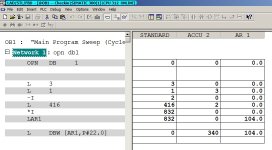Gents,
I've not had much dealings with indirect addressing, but I'm troubleshooting a program now, and I just wanted to verify that I've come to some level of understanding.
thanks for your help
I've not had much dealings with indirect addressing, but I'm troubleshooting a program now, and I just wanted to verify that I've come to some level of understanding.
Code:
L 3
L 1
-I //3-1= 2
L 416
*I //2*416 = 832
LAR1 //load 832 into AR1
L DBW [AR1,P#22.0 //load the value found in DBW832 with a 22byte offset, which would be dbw854???thanks for your help





